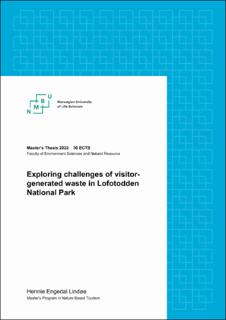| dc.description.abstract | Norway has many scenic and pristine national parks which are desired destinations for foreign and domestic tourists. More visits are encouraged into the parks as they bring local value creation, prompting management to seek enhanced visitor experiences. Recreational activity in vulnerable areas creates pressure and disturbance on ecological values, wildlife, and can detract the experiences in over-visited areas. My thesis explored the challenges of visitor-generated waste in Lofotodden National Park, related to the popular hiking and camping destination of Kvalvika beach. The main objective was to: Explore the challenges of visitor-generated waste in Lofotodden National park in order to create an understanding of the scope of the problem as seen from the tourists’ perspective, investigate visitor-waste relationships and provide initial guidelines for possible management measures.
To answer the objective, the study applied an exploratory, mixed method approach using quantitative date from a field waste survey to monitor and map out key locations visitors dispose their waste, and “hot spots” where waste accumulates over the main tourist season, combined with observations of waste distribution and visitors’ behaviors and 26 qualitative semi structured in-depth interviews with visitors. Ajzen’s (1991) “theory of planned behavior” was used as a guiding theory, for identifying some of the prominent attitudes, subjective norms and the perceived behavior control visitors hold towards human waste behavior and management at the specific case area Kvalvika, within Lofotodden National Park.
The findings from the three different methods identify and assess different aspects of the littering problem at Kvalvika. The fieldwork documents that littering is visible, accumulating, and dispersed over a gradually larger area during the main tourist season. Littering takes place near informal campsites, and the most common finding is human feces and toilet paper. Observations show that visitors camp close to surface-disposed human feces and use water sources prone to unwanted bacteria without treatment for a variety of personally hygienic activities, such as filling water bottles and brushing teeth. This raises concerns about visitors' health and degradation/wear of protected nature values. The interviews on the other hand find visitors do not perceive a particular waste problem at Kvalvika and experience it as a clean area. They have clearly negative attitudes towards littering. At the same time, the informants do not perceive toilet waste directly as litter, even though toilet paper was often encountered. Very few mentioned littering as problematic for humans, wildlife, or other ecological values, instead the problem was mainly related to aesthetic conditions, according to visitors. Visitors see it as a social norm not to litter and ask for simple management measures, if any. In particular, they support increased information, encouragement to bring "all" waste out, and guidelines for going to the bathroom in nature and to be more considerate of others. However, they do not want to be blamed for littering, which is seen as lazy or uneducated behaviors of others. They are negative or hesitant about "hard" management measures. The tourists see themselves as having the primary responsibility for keeping nature clean.
Management can address the waste challenges with various measures, from indirect encouraging and persuasive messaging of wanted behavior from visitors to more direct regulation of access or larger physical measures such as toilets on the beach. Studies on the effect of different waste measures are minimal and adaptive approaches is recommended. Further research is needed to limit man-made waste in national parks and understand the impact of waste on ecological and social values. This study helps to identify areas that are important for further research, that will provide a better basis for effective management measures against littering in the future. | en_US |

